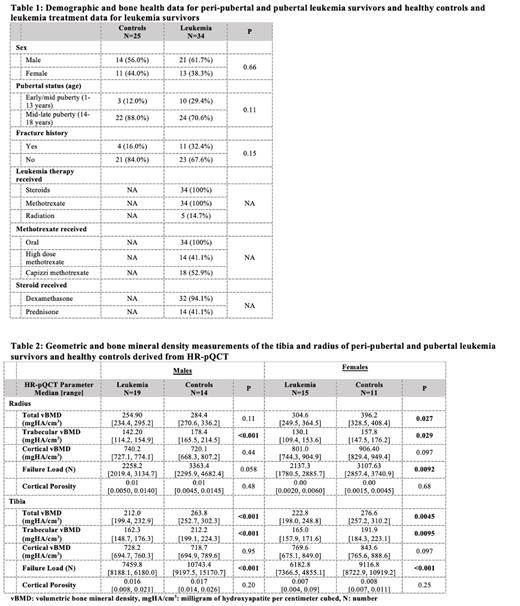Bone mass accrual, bone architecture, and strength may be impaired in children with a history of acute lymphoblastic leukemia (ALL) resulting in low bone mineral density (BMD) and fractures. The Children's Oncology Group recommends evaluating ALL survivors' bone health with dual-energy X-ray absorptiometry (DXA) testing. However, DXA testing may not accurately measure bone health in survivors due to low bone area for height, short stature, growth delays or decreased lean muscle mass. Further, it does not differentiate between trabecular and cortical bone, nor does it provide insights into bone microarchitecture and strength. High-resolution peripheral quantitative computed tomography (HR-pQCT) is a three-dimensional non-invasive imaging modality that provides a comprehensive assessment bone microarchitecture, volumetric BMD (vBMD) of both cortical and trabecular bone, and bone strength. In adult patients, HR-pQCT parameters have been shown to predict incident fractures. In this pilot study we utilized HR-pQCT to evaluate bone microarchitecture, vBMD, bone geometry and bone strength of peri-pubertal and pubertal survivors of ALL compared to healthy controls.
Methods: We prospectively recruited ALL survivors (>1 year off therapy) with a DXA BMD Z-score between -2.0 to 0 within the proceeding six months, who were in early-late puberty (pre-pubertal patients excluded), and aged 11 to 18 years, along with healthy controls in the same age range at a single academic pediatric center in Canada. While a BMD Z-score of -2.0 to 0 has historically been considered normal, many children with Z-scores in this range have skeletal fragility and an increased fracture risk. Patients were excluded if they had comorbidity that impacts bone microarchitecture (ex. chronic kidney disease), were on a medication that impacts bone health (ex. corticosteroids) or had a genetic syndrome that increased their sensitivity to radiation (ex. Ataxia Telangiectasia). HR-pQCT of the distal radius and tibia was performed using the a standardized protocol. Bone mass was compared using total, trabecular and cortical vBMD, bone architecture was compared using cortical porosity and bone strength was compared using failure load. HR-pQCT derived variables were compared between ALL and control groups following stratification by sex. HR-pQCT values were summarized using medians and interquartile ranges and medians were compared using the Wilcoxon signed-rank test. Demographic and clinical characteristics were compared using the chi-square test. All tests were two tailed and p<0.05 was considered significant.
Results: A total of 59 subjects were recruited (34 ALL survivors, 25 healthy controls). The sex of participants was male for 56.0% (n=14) of controls and 61.7% (n=21) of ALL survivors and female for 44.0% (n=11) of controls and 38.3% (n=13) of survivors. All survivors had received corticosteroids and methotrexate, and five (15%) had received cranial radiation. ALL survivors were not more likely than controls to report a history of a fracture (32.4%, n=11 vs. 16%, n=4). Additional data regarding the participants demographics is presented in Table 1. Male survivors had a lower radial trabecular vBMD, tibial total vBMD, and tibial trabecular vBMD, and a higher tibial failure load compared to healthy male controls. Female survivors had a lower radial total vBMD, radial trabecular vBMD, tibial total vBMD, and tibial trabecular vBMD. Female ALL survivors also had higher radial and tibial failure loads compared to healthy female controls. No differences in cortical porosity or cortical vBMD were identified between survivors and healthy controls. Complete HR-pQCT data is presented in Table 2.
Conclusions: We demonstrated differences in the HR-pQCT parameters of peripubertal and pubertal ALL survivors compared to healthy controls. Survivors had reductions in key HR-pQCT parameters and an increased tibial failure load compared to healthy controls. In future studies HR-pQCT should be performed at a uniform time point post ALL therapy and used to predict future adverse bone health outcome such as fractures. Using this HR-pQCT guided approach ALL survivors at greatest risk of an adverse bone health outcome can be offered early interventions to prevent these outcomes.
Disclosures
No relevant conflicts of interest to declare.


This feature is available to Subscribers Only
Sign In or Create an Account Close Modal